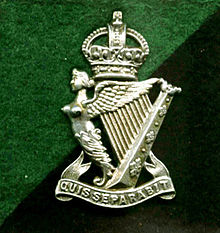| Royal Irish Rifles Royal Ulster Rifles | |
|---|---|
 Cap badge | |
| Active | 1881–1968 |
| Country | |
| Branch | |
| Type | Rifles |
| Role | Light infantry |
| Size | 1-2 Regular battalions 3 Militia and Special Reserve battalions Up to 16 Hostilities-only battalions |
| Garrison/HQ | RHQ – Victoria Barracks, Belfast (1881-1937) St Patrick's Barracks, Ballymena (1937-1968) |
| Nickname(s) | The Stickies,[1] The Rifles |
| Motto(s) | Quis Separabit (Who shall separate us [from the love of Christ]) (Latin) |
| Colours | None as a rifle regiment |
| March | Quick: "The Ulster Rifles march 'Off, Off, Said the Stranger'" Pipes and Drums: "South Down Militia" |
| Anniversaries | Somme Day, 1 July |
| Engagements | Badajoz, Jhansi, Somme, Normandy Landings, Rhine Crossing, Korea |
| Insignia | |
| Abbreviation | RUR (RIR) |
The Royal Irish Rifles (became the Royal Ulster Rifles from 1 January 1921) was an infantry rifle regiment of the British Army, first created in 1881 by the amalgamation of the 83rd (County of Dublin) Regiment of Foot and the 86th (Royal County Down) Regiment of Foot. The regiment saw service in the Second Boer War, the First World War, the Second World War, and the Korean War.
In 1968 the Royal Ulster Rifles was amalgamated with the other regiments of the North Irish Brigade, the Royal Irish Fusiliers (Princess Victoria's), and the Royal Inniskilling Fusiliers to create the Royal Irish Rangers.
- ^ Chant, p. 85